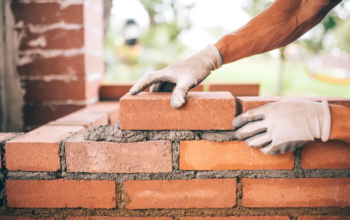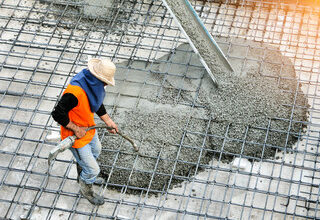Bricklayers work with clay bricks and concrete blocks and construct and repair walls, partitions, and arches. They also specialize in tuckpointing, a process that enhances the appearance of masonry.
Individuals can become bricklayers by undertaking a bricklaying course with a college or private training provider. Relevant work experience can also help. For more information, click the Website to proceed.

Getting into bricklaying as a career requires formal qualifications and training. Individuals can enroll in a vocational course at college or private training providers or apply for an apprenticeship. Work experience is also useful and can help individuals decide if bricklaying is the right career.
Individuals can join a trade association, offering industry recognition, continuing professional development (CPD), and networking opportunities. This will allow them to stay abreast of new developments in the construction industry and advance their career.
To become a bricklayer, individuals must acquire relevant technical skills and a strong work ethic. Bricklayers must also be able to communicate effectively and solve problems on-site. Depending on the type of project, they may be exposed to harsh working conditions, such as extreme heat or cramped workspaces. They must also be able to handle heavy materials and stand for long periods.
In addition to technical training, bricklayers must be able to follow strict safety guidelines. They must wear protective clothing, equipment, a hard hat, and safety glasses. They must also be able to operate machinery, such as cranes, dumpers, and power tools.
Bricklayers can specialize in various aspects of the craft, including refractory and decorative stonework, tuckpointing, and restoration projects. In addition, they can decide to move up the career ladder and become a supervisor or team leader. They can also train in other skilled trades, such as stonemasonry or tiling.
As they gain experience, bricklayers can also consider pursuing other careers in the construction industry. For example, they can become supervisors or team leaders or move into other business areas, such as contract management or estimating. They can also become a trainer at a college or private training provider or move into memorial masonry.
Having a career in bricklaying is a rewarding experience, but it can be challenging to maintain. It is important to decide early on what you want to achieve and how you will get there. You can then chart a clear course for your career and develop a robust portfolio of work to showcase your expertise.
Bricklayers construct, repair, and maintain walls, chimneys, foundations, and other masonry structures using brick, concrete blocks, and stone. They follow technical plans and specifications when constructing or repairing. They may also be involved in restoration projects, particularly those involving decorative brickwork. They specialize in tuckpointing, which enhances masonry’s cosmetic appearance by removing damaged mortar and filling joints with fresh mortar. They use various tools and equipment, including specialized bricklaying machinery.
To complete their duties, bricklayers must adhere to strict health and safety guidelines. They must be aware of potential hazards such as exposure to dust and brick dust, manual handling of materials, working at heights, confined spaces, and power tools. They must also be able to work in adverse weather conditions. Depending on the project requirements, they may be required to wear protective clothing and masks.
Bricklayers usually undergo an apprenticeship, which lasts three or four years. During this time, they work with experienced bricklayers on construction sites to learn practical skills. In addition, they attend classroom instruction to learn about building regulations, mathematics, and construction techniques. To become fully qualified bricklayers, they must finish at least 144 hours of classroom instruction per year and 2,000 hours of paid hands-on training.
Once they have completed their apprenticeship, bricklayers can become self-employed or work for a company specializing in masonry construction. These companies can provide them with a steady flow of work and offer opportunities for career progression. In addition, some bricklayers are members of professional or public bodies, federations, and associations that can provide support, memberships, and events to help them build their careers.
Daily job duties include measuring and marking the work area, laying bricks, blocks, and paving slabs according to the project’s specifications, and working to specific deadlines. They may also be responsible for securing and resurfacing foundations, setting out initial rows of bricks, installing damp course or blockwork, constructing chimneys and ornamental brickwork, cutting and shaping bricks, and mixing mortar/mud. Other responsibilities include ensuring the work is safe and secure, cleaning up the site, and liaising with other tradespeople, such as builders, carpenters, and plasterers.
Bricklayers work on a variety of building sites. They may build large commercial developments or new homes and repair chimneys, walls, and tunnel linings. They also carry out ornamental work, such as laying shaped or colored brickwork in buildings and arches. They must be very accurate and are expected to follow blueprints. They use trowels, hammers, shovels, and bolsters to lay materials. They also use mixing equipment to keep mortar from setting too quickly. They are often assisted by helpers who carry heavy materials and mix the concrete. Bricklayers wear hard hats and safety glasses and must be trained in health and safety procedures.
Some bricklayers specialize in stonework, while others work with other construction materials, such as concrete or cinder blocks. Construction companies or bricklaying contractors normally employ them and may be self-employed. Some bricklayers also refurbish masonry and brickwork on restoration projects. Bricklayers spend much of their time outdoors and are exposed to all types of weather. They must be able to work at heights on scaffolding and may also need to travel between sites.
Many bricklayers learn their trade by working as apprentices under experienced craft workers. These apprenticeship programs usually last three years and combine on-the-job training with classroom instruction. The requirements for becoming an apprentice vary but are generally a high school diploma or equivalent and a willingness to commit to the work.
A bricklayer’s daily tasks include consulting building plans and measuring and binding building materials with mortar. They also construct, repair, and maintain walls, partitions, and paving. They also erect and dismantle scaffolding and other installation structures. They may also clean the work area and equipment. Contact with wet cement products such as mortar can cause skin problems, including dermatitis and burns. Mortar also contains crystalline silica, which can cause respiratory illnesses if inhaled.
Bricklayers must wear a dust mask to protect their lungs from the fine particulates produced during work. In addition, they should wear a hard hat, safety glasses, and steel-capped boots to reduce the risk of injury. They must also be aware of potential hazards, such as the possibility of falling or collapsing from heights, and use proper hand-washing techniques to avoid infections from wet materials.
Bricklayers can find work across a variety of industries and locations. They can also choose to specialize in a particular area of the profession, such as heritage restoration or construction management. They can work independently on smaller jobs or in a gang working alongside other tradespeople (such as bricklayers, joiners, plasterers, carpenters, plumbers, tilers, electricians, decorators, etc). They can also be self-employed and work freelance for a recruitment agency or on a contract basis.
The salaries of bricklayers vary according to their level of expertise and experience. They can also earn more by undergoing training and certification in specialized areas. Their income can also be impacted by the type of projects they work on and whether or not they are completing overtime hours.
Bricklayers can earn up to $87,000 annually, depending on their location and employer. This includes taxable wages, tips, and bonuses. It also provides for the cost of any additional equipment or tools that they use to carry out their duties. Those specializing in heritage restoration or construction management may also be eligible for higher pay.
A career as a bricklayer can be very rewarding and exciting. However, it can be physically demanding and stressful. Those who choose to work in the field are exposed to harsh weather conditions and can face health risks, such as exposure to brick dust and chemicals. They may also be at risk of injuries from heavy lifting, falls, and mishaps with tools.
Bricklayers can work across various construction and repair projects, including roads, bridges, railways, and commercial buildings. They can also be employed by local government or public and private construction companies. Those who work in highway, road, and bridge construction can expect to make $75,990 per year on average.
A good bricklayer can lay up to 500 bricks daily, although the number will depend on the job’s complexity and working conditions. Those who are more experienced can usually lay more bricks per day. They can also earn a higher income by taking on more complex jobs or working for larger, more reputable construction firms.



